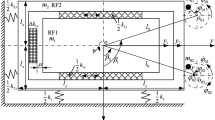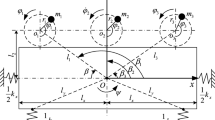Abstract
This paper focuses on the stability of three homodromy vibrators in a vibrating system with two rigid frames (RFs). The motion differential equations of the system are established. Using the average method yields the average coupling torque balanced equations of three vibrators, and the simplified analytical expressions for synchronization and stability criterions of the system were derived. The coupling dynamic characteristics were numerically analyzed, including frequency-amplitude response, stable phase differences, synchronization and stability ability, and phase relationships. The simulations to verify the validity of theoretical results were carried out. It is shown that the stable states of the system are classified into three types, thereof the stability of phase differences among vibrators is similar in sub-resonant and super-resonant states, which results in no vibration of the system. While in near sub-resonant state the system reflects strong useful positive superposition vibration with energy saving, which is exactly the desire in engineering design.
Similar content being viewed by others
Abbreviations
- f 0 i :
-
Damping coefficient of the induction motor i, i = 1, 2, 3
- f jx :
-
Damping constant of the RF j in x-direction, j = 1, 2
- k jx :
-
Stiffness of the spring in x-direction, i = 1, 2, 3
- m 1 :
-
Mass of the RF1
- m 2 :
-
Mass of the RF2
- m 0 :
-
Mass of the standard vibrator
- m 0 i :
-
Mass of the vibrator i, m0i = m0, i = 1, 2, 3
- m :
-
Induced mass of the vibrating system, m = M′1M′2/(M′1+ M′2), M′1 ≈ M1, M′2 = M2
- M :
-
Mass of the total vibrating system, M = M1 + M2, M1 = m1, M2 = m2 + m01 + m02 + m03
- r i :
-
Eccentric radius of three vibrators, ri = r, i = 1, 2, 3
- r m :
-
Mass ratio between the standard vibrator and the total vibrating system, rm = m0/M
- r m1 :
-
Mass ratio between the RF1 and the total system, rm1 = M1/M
- r m2 :
-
Mass ratio between the standard vibrator and the RF2, rm2 = m0/M2
- T ei :
-
Electromagnetic torque of the induction motor i, i = 1, 2, 3
- T e0 i :
-
Electromagnetic torque of the induction motor i operating steadily, i = 1, 2, 3
- z i :
-
Frequency ratio between the operating frequency and natural frequencies, zi = ωm0/ωi, i = 0, 1
- ω m0 :
-
Synchronous angular velocity of three vibrators when the induction motors operate steadily
- ω 1 :
-
Natural frequency of the RF1, \({\omega _1} = \sqrt {\left( {{k_{1x}} + {k_{2x}}} \right)/{M_1}} \)
- ω 0 :
-
Natural frequency of the main vibrating system, \({\omega _0} = \sqrt {{k_{2x}}/m} \)
- ω g :
-
Natural frequency of the isolated vibrating system, \({\omega _g} = \sqrt {{k_{1x}}/M} \)
- γ jx :
-
Phase lag angle of the RF j in x-direction, j = 1, 2
- ξ jx :
-
Critical damping ratio of the RF j in x-direction, j = 1, 2
- η i :
-
Mass ratio between the vibrator i and the standard vibrator, ηi = m0i/m0, i = 1, 2, 3
- \((\dot \bullet )\) :
-
d ● /dt
- \((\ddot \bullet )\) :
-
d2 ● /dt2
References
J. Rayleigh and J. W. Strutt, The Theory of Sound, Dover, London (1877).
C. Zhou, Y. B. Liu and X. M. Rui, Mechanism and characteristic of rain-induced vibration on high-voltage transmission line, J. of Mechanical Science and Technology, 26 (8) (2012) 2505–2510.
M. Kapitaniak et al., Synchronization of clocks, Physics Reports, 517 (2012) 1–69.
G. V. Osipov, J. Kurths and C. S. Zhou, Synchronization in Oscillatory Networks, Springer, Berlin Heidelberg (2007).
R. Yamapi and P. Woafo, Dynamics and synchronization of coupled self-sustained electromechanical devices, J. of Sound and Vibration, 285 (2005) 1151–1170.
J. A. Acebrón et al., The Kuramoto model: A simple paradigm for synchronization phenomena, Reviews of Modern Physics, 77 (1) (2005) 137–185.
P. Perlikowski, A. Stefański and T. Kapitaniak, 1:1 mode locking and generalized synchronization in mechanical oscillators, J. of Sound and Vibration, 318 (2008) 329–340.
H. A. Tanaka, A. J. Lichtenberg and S. Oishi, Self-synchronization of coupled oscillators with hysteretic responses, European Physical J. D, 100 (1997) 279–300.
I. I. Blekhman, Vibrational Mechanics, World Scientific, Singapore (1988).
I. I. Blekhman et al., On self-synchronization and controlled synchronization, Systems & Control Letters, 31 (5) (1997) 299–305.
I. I. Blekhman et al., Self-synchronization and controlled synchronization: General definition and example design, Mathematics and Computers in Simulation, 58 (2002) 367–384.
I. I. Blekhman and V. S. Sorokin, On the separation of fast and slow motions in mechanical systems with high-frequency modulation of the dissipation coefficient, J. of Sound and Vibration, 329 (23) (2010) 4936–4949.
J. Inoue and Y. Araki, Self-synchronization of mechanical system (multiple cycle), Proceedings of Japanese Mechanical Engineering Society, 42 (1981) 103–110 (in Japanese).
B. C. Wen et al., Vibratory Synchronization and Controlled Synchronization in Engineering, Science Press, Beijing (2009).
B. C. Wen et al., Theory and techniques of vibrating machinery and their applications, Science Press, Beijing (2010).
J. M. Balthazar, J. L. P. Felix and R. M. Brasil, Short comments on self-synchronization of two non-ideal sources supported by a flexible portal frame structure, J. of Vibration and Control, 10 (12) (2004) 1739–1748.
J. M. Balthazar, J. L. P. Felix and R. M. Brasil, Some comments on the numerical simulation of self-synchronization of four non-ideal exciters, Applied Mathematics and Computation, 164 (2) (2005) 615–625.
A. Teufel, A. Steindl and H. Troger, Synchronization of two flow excited pendula, Communications in Nonlinear Science and Numerical Simulation, 11 (5) (2006) 577–594.
P. Fang and Y. J. Hou, Synchronization characteristics of a rotor-pendula system in multiple coupling resonant systems, Proceedings of the Institution of Mechanical Engineers, Part C: J. of Mechanical Engineering Science, 232 (10) (2017) 1802–1822.
P. Fang et al., Study of synchronization for a rotor-pendulum system with poincare method, J. of Vibroengineering, 17 (5) (2015) 2681–2695.
X. L. Zhang, B. C. Wen and C. Y. Zhao, Vibratory synchronization transmission of a cylindrical roller in a vibrating mechanical system excited by two exciters, Mechanical Systems and Signal Processing, 96 (2017) 88–103.
X. L. Zhang, B. C. Wen and C. Y. Zhao, Vibratory synchronization transmission of two exciters in a super-resonant vibrating system, J. of Mechanical Science and Technology, 28 (6) (2014) 2049–2058.
X. L. Zhang et al., Synchronous stability of four homodromy vibrators in a vibrating system with double resonant types, Shock and Vibration (2018) Article ID 9641231, 20.
C. Y. Zhao et al., Synchronization of two non-identical coupled exciters in a non-resonant vibrating system of linear motion part I: theoretical analysis, Shock and Vibration, 16 (5) (2009) 505–516.
Acknowledgments
This work was supported by the National Natural Science Foundations of China [grant number 51675090], the Fundamental Research Funds for the Central Universities [grant number N170304013] and China Postdoctoral Science Foundation [grant number 2017M621145].
Author information
Authors and Affiliations
Corresponding author
Additional information
Recommended by Associate Editor Dongho Oh
Xueliang Zhang received his Ph.D. from Northeastern University, Shenyang, China. He is currently an Associate Professor in the School of Mechanical Engineering and Automation, Northeastern University, China. His research interests include synchronization theory, vibration utilization engineering, and nonlinear vibration in engineering.
Rights and permissions
About this article
Cite this article
Zhang, X., Wang, Z., Li, C. et al. Comments on the stability of the synchronous states of three vibrators in a vibrating system with two rigid frames. J Mech Sci Technol 33, 4659–4672 (2019). https://doi.org/10.1007/s12206-019-0909-6
Received:
Revised:
Accepted:
Published:
Issue Date:
DOI: https://doi.org/10.1007/s12206-019-0909-6




